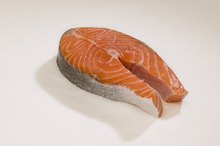What does fact checked mean?
At Healthfully, we strive to deliver objective content that is accurate and up-to-date. Our team periodically reviews articles in order to ensure content quality. The sources cited below consist of evidence from peer-reviewed journals, prominent medical organizations, academic associations, and government data.
- MayoClinic.com: Sodium: How to Tame Your Salt Habit Now
- National Institutes of Health: Dietary Supplement Fact Sheet: Selenium
The information contained on this site is for informational purposes only, and should not be used as a substitute for the advice of a professional health care provider. Please check with the appropriate physician regarding health questions and concerns. Although we strive to deliver accurate and up-to-date information, no guarantee to that effect is made.
Nutrition of Mahi Mahi Vs. White Fish
**According to MayoClinic.com, eating fish on a weekly basis might reduce your risk of heart-related problems.
Fish contains omega-3 fatty acids, which reduce your risk of dying from a heart attack. ** Mahi-mahi and whitefish are both nutritious sources of omega-3 fatty acids, but also supply additional key nutrients that support your health. The nutrition facts for each type of fish helps you determine if one or the other deserves a place in your healthy eating plan.
Calories and Fat
Mahi-mahi is lower in calories and fat than whitefish. A 3-ounce serving of mahi-mahi contains 85 calories and less than 1 gram of fat. The same amount of whitefish contains 265 calories and 12 grams of total fat. Whitefish contains 2 grams of saturated fat, which is about 10 percent of your daily limit. If you eat fish regularly, mahi-mahi is a healthier choice as too much saturated fat increases your risk of heart disease, diabetes, cancer and obesity. Because mahi-mahi has fewer calories than whitefish, it also aids you in maintaining a healthy weight.
- Mahi-mahi is lower in calories and fat than whitefish.
- Because mahi-mahi has fewer calories than whitefish, it also aids you in maintaining a healthy weight.
Cholesterol
What Are the Benefits of Salmon Patties?
Learn More
Many types of seafood are high in cholesterol, which might cause you to proceed with caution when eating fish. Both mahi-mahi and whitefish contain cholesterol, but they are not unhealthy sources. **According to the Harvard School of Public Health, the cholesterol found in your food is less likely to cause illness or disease than your intake of saturated fat.
A serving of mahi-mahi contains 73 milligrams of cholesterol. ** A serving of whitefish contains more with 119 milligrams, or 39 percent of your daily limit.
- Many types of seafood are high in cholesterol, which might cause you to proceed with caution when eating fish.
- Both mahi-mahi and whitefish contain cholesterol, but they are not unhealthy sources.
Protein
Mahi-mahi and whitefish both supply a healthy dose of protein. Protein is essential for many of your bodily functions, including oxygen transport and energy production. The amino acids in foods, such as fish, enable your body to make use of proteins. According to the Harvard School of Public Health, your body does not store amino acids.
Aim to get 8 grams of protein for every 20 pounds of your body weight.
A serving of mahi-mahi supplies 18.5 grams of protein. A serving of whitefish provides more than double, at 38 grams.
- Mahi-mahi and whitefish both supply a healthy dose of protein.
Additional Nutrients
Is Whiting Fish High in Omega 3?
Learn More
Because mahi-mahi and whitefish are ocean creatures, they contain sodium from the salt water that make up their habitat. MayoClinic.com notes that you should limit your intake of sodium to 2,300 milligrams or less per day, but mahi-mahi and whitefish contain only small amounts 2.
A serving of mahi-mahi contains only 88 milligrams of sodium. A serving of whitefish contains just 101 milligrams. Mahi-mahi is also a healthy source of selenium, a mineral that that helps protect you from the damage caused by free radicals. A serving of mahi-mahi contains 36.5 micrograms of the 55 micrograms of selenium you need each day.
- Because mahi-mahi and whitefish are ocean creatures, they contain sodium from the salt water that make up their habitat.
- A serving of mahi-mahi contains 36.5 micrograms of the 55 micrograms of selenium you need each day.
Mercury
Many types of fish contain elevated levels of mercury. Mercury can accumulate in your bloodstream, and is particularly dangerous for pregnant women. Too much mercury can cause your unborn baby to sustain nervous system damage. If you are pregnant, speak with your doctor about eating fish to determine safe amounts and types for you.
All fish contain some amount of mercury, but larger fish, such as shark and swordfish, are particularly dangerous. Smaller fish, such as mahi-mahi and whitefish, are considered safer choices because they do not contain as much mercury.
- Many types of fish contain elevated levels of mercury.
- All fish contain some amount of mercury, but larger fish, such as shark and swordfish, are particularly dangerous.
Related Articles
References
- National Oceanic and Atmospheric Administration: Mahi-mahi (Dolphinfish)
- MayoClinic.com: Sodium: How to Tame Your Salt Habit Now
- National Institutes of Health: Dietary Supplement Fact Sheet: Selenium
- United States Environmental Protection Agency: What You Need to Know about Mercury in Fish and Shellfish
Writer Bio
Sara Ipatenco has taught writing, health and nutrition. She started writing in 2007 and has been published in Teaching Tolerance magazine. Ipatenco holds a bachelor's degree and a master's degree in education, both from the University of Denver.









